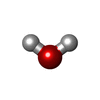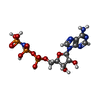+Search query
-Structure paper
| Title | Capture, mutual inhibition and release mechanism for aPKC-Par6 and its multisite polarity substrate Lgl. |
|---|---|
| Journal, issue, pages | Nat Struct Mol Biol, Vol. 32, Issue 4, Page 729-739, Year 2025 |
| Publish date | Jan 6, 2025 |
 Authors Authors | Christopher P Earl / Mathias Cobbaut / André Barros-Carvalho / Marina E Ivanova / David C Briggs / Eurico Morais-de-Sá / Peter J Parker / Neil Q McDonald /   |
| PubMed Abstract | The mutually antagonistic relationship of atypical protein kinase C (aPKC) and partitioning-defective protein 6 (Par6) with the substrate lethal (2) giant larvae (Lgl) is essential for regulating ...The mutually antagonistic relationship of atypical protein kinase C (aPKC) and partitioning-defective protein 6 (Par6) with the substrate lethal (2) giant larvae (Lgl) is essential for regulating polarity across many cell types. Although aPKC-Par6 phosphorylates Lgl at three serine sites to exclude it from the apical domain, aPKC-Par6 and Lgl paradoxically form a stable kinase-substrate complex, with conflicting roles proposed for Par6. We report the structure of human aPKCι-Par6α bound to full-length Llgl1, captured through an aPKCι docking site and a Par6 contact. This complex traps a phospho-S663 Llgl1 intermediate bridging between aPKC and Par6, impeding phosphorylation progression. Thus, aPKCι is effectively inhibited by Llgl1 while Llgl1 is captured by aPKCι-Par6. Mutational disruption of the Lgl-aPKC interaction impedes complex assembly and Lgl phosphorylation, whereas disrupting the Lgl-Par6 contact promotes complex dissociation and Lgl phosphorylation. We demonstrate a Par6-regulated substrate capture-and-release model requiring binding by active Cdc42 and the apical partner Crumbs to drive complex disassembly. Our results suggest a mechanism for mutual regulation and spatial control of aPKC-Par6 and Lgl activities. |
 External links External links |  Nat Struct Mol Biol / Nat Struct Mol Biol /  PubMed:39762628 / PubMed:39762628 /  PubMed Central PubMed Central |
| Methods | EM (single particle) / X-ray diffraction |
| Resolution | 2.591 - 3.68 Å |
| Structure data | EMDB-18877, PDB-8r3y:  PDB-8r3x: |
| Chemicals |  ChemComp-HOH:  ChemComp-ANP: |
| Source |
|
 Keywords Keywords | CYTOSOLIC PROTEIN / Kinase / Polarity / Kinase substrate complex. |
 Movie
Movie Controller
Controller Structure viewers
Structure viewers About Yorodumi Papers
About Yorodumi Papers





 homo sapiens (human)
homo sapiens (human)